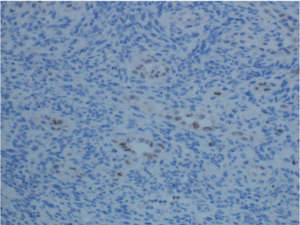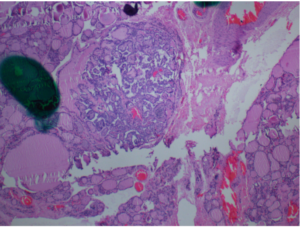Anaplastic Thyroid Carcinoma in Metastatic Lateral Cervical Neck Lymph Node. Case Report and Review literatures

Global Journal of Pathology & Laboratory Medicine
Volume 1, Issue 2, April 2021, Pages: 1-7
Received: April 24, 2021; Reviewed: May 10, 2021; Accepted: May 13, 2021; Published: May 17, 2021
Unified Citation Journals, Pathology 2021, 1(2) 1-07; https://doi.org/10.52402/Pathology0201
ISSN 2754-0952
Authors: Dr. Rhagad Tallab, Dr. Doaa Al Ghamdi![]()
Department of Anatomic Pathology and Laboratory Medicine, King Fahad Medical City, Riyadh, Saudi Arabia.
Introduction:
Papillary thyroid carcinoma is one of the commonest human malignancies. It usually follows an indolent clinical course with localized disease and rare metastasis [1]. Anaplastic transformation of thyroid carcinoma although rare but is well-accepted phenomena. It goes through multiple steps of genetic alterations leading to an ultimate de-differentiation. Most of the anaplastic carcinoma occurs in the thyroid glands with very aggressive behavior and locally advanced disease [2]. Recently some case reports described the anaplastic transformation of thyroid carcinoma in a distant site. It occurred either synchronously or years after diagnosis of thyroid carcinoma.
2. Case Report:
84 years old male presented with painful right neck swelling for four years, gradually increasing in size. The patient underwent a head/neck computerized tomography (CT) scan and it showed an 8.0 cm right neck mass at level IIa/III with a cystic component, the central area of necrosis, and calcifications. The mass was inseparable from the adjacent sternocleidomastoid muscle (Figure A and B). Also, bilateral thyroid complex cystic nodules were noted with the largest seen within the left lobe measuring 3.1 cm.
Figure (A&B) A right neck mass at level IIa/III with a cystic component (Red irregular circle), the central area of necrosis, and calcifications (black arrow). The mass was inseparable from the adjacent sternocleidomastoid muscle.
A Fine needle aspiration (FNA) biopsies were performed on both neck and thyroid lesions. Both lesions were labeled as “Atypia of undetermined significance”. A subsequent total thyroidectomy and excision of the neck mass were performed with lymph nodes dissection,
Figure 2: Grossing: A large Lateral Cervical Heterogenous Solid Tan Cut Surface Mass with Cystic Spaces and Islands of Necrosis.
Grossly we received a total thyroid gland with lobulated surface. Multiple nodules were identified ranging from 0.3 – 2.7 cm with variable solid and cystic cut surfaces. The neck mass received oriented measuring 12.7 cm in greatest diameter (figure 2). It had a heterogenous solid tan cut surface with cystic spaces and islands of necrosis. It was inseparable from the adjacent identified skeletal muscle.
Figure 3: Lateral neck lymph node mass: H&E 4x: Diffuse replacement of lymph node with rime of lymphoid aggregate at the edge
Histologically: Lateral neck mass showed a rime of lymphoid cells and capsule (Figure 3) infiltrated by a malignant neoplasm composed of a sheet of large undifferentiated pleomorphic cells with spindle (Figure 4), plasmacytoid and epithelioid morphology and with abundant eosinophilic cytoplasm (Figure 5). The nuclei were enlarged with obvious nucleoli and frequent mitotic figures.
Figure 4: Lateral Neck Lymph Node Mass: H&E10X: Microscopic Appearance of Tumor is Diffuse Sheet of Epitheliod Cells.
Lateral neck lymph node mass: H& E 10x: tumor coagulative necrosis.
Figure 5: Lateral neck lymph node mass: H&E 20X: Rhabdoid like tumor cells with an inflammatory background.
There were multiple foci of necrosis, perineural invasion, lymph-vascular invasion, and extensive skeletal muscle invasion.
Figure 6: Lateral neck lymph node mass: CK7 stain: positive in tumour cells.
Figure 7: Lateral neck lymph node mass: H&E 20X: Spindle cells neoplastic cells and rare abortive glands in between.
Figure 8: Lateral neck lymph node mass: Pax 8 stain is positive in rare scattered cells.
There were multiple foci of necrosis, perineural invasion, lymph-vascular invasion, and extensive skeletal muscle invasion. A broad panel of immunohistochemicall studies were performed on the neck mass and the neoplastic cells came diffusely positive for CKAE1/3, CK7 (Figure 6), CK18, and vimnetin and focally positive for myoepithelial markers. Rare glands like cells (Figure 7) are expressed to Pax-8 stain (Figure 8). The neoplastic cells were negative for the squamous marker (p63, CK5/6) and were consistently negative for TTF-1 and thyroglobulin. Other sarcomas, lymphoma, and Melanoma markers came also negative. INI-1 nuclear stain was preserved.
Figure 9: Thyroid lobe: Dot is papillary microcarcinoma
The thyroid tissue is submitted entirely for microscopic examination showing papillary microcarcinoma, a classical variant limited to thyroid parenchyma (Figure9).
The possibility of anaplastic transformation of metastatic papillary carcinoma was considered and molecular studies were carried on. The molecular tests revealed that the malignant cell was positive for BRAF codon 600 (V600E/D) mutation. Based on the molecular studies, the positivity of Pax-8 and the presence of papillary carcinoma in the thyroid this favored the diagnosis of anaplastic thyroid carcinoma in a lateral neck lymph node.
On follow-up of the patient, he developed lung and iliac bone metastasis which wasn’t biopsied because of the poor situation of the patient. Unfortunately, the patient is currently on palliative therapy and signed DNR status due to worsening of his condition.
3. Discussion:
Anaplastic thyroid carcinoma is the most aggressive thyroid epithelial neoplasm accounting for less than 5% of thyroid malignancies. It represents a terminal form of de-differentiation with high mortality and short survival rate [2]. Most of anaplastic thyroid carcinoma harbor areas of better differentiation and are located within the thyroid itself [3]. Recently some cases described the occurrence of anaplastic transformation of pre-existing well-differentiated thyroid carcinoma in a distant site (Table1). These transformations were most frequently encountered in the regional lymph nodes and lung [4, 5]. However, other sites including reteroperitonium [6], mandible [7] and even as soft tissue mass were also reported [8]. The anapestic carcinoma didn’t necessarily present in the thyroid gland and in some cases it only appeared in the metastatic sites making a diagnostic confusion. It mostly presents years after the initial diagnosis of thyroid malignancy with a highly aggressive transformed disease [9]. Ito et al described a follow up of five patients with anaplastic transformation in lymph nodes.
Their study concluded that long-term survival can be expected for patients with anaplastic transformation in the lymph node if it is curatively resected [10]. Unfortunately, most of the cases presented with advanced disease, multiple metastasis and a dismal prognosis.
| Case 1
Ito Yet al (10) |
Case 2
Ito Yet al (10) |
Case 3
Ito Yet al (10) |
Case 4
Ito Yet al (10) |
Case 5
Ito Yet al (10) |
Case 6
Our case |
|
| Age | 64 | 80 | 51 | 79 | 77 | 84 |
| Gender | Male | Female | Female | Male | Female | Male |
| Size of thyroid tumour | 3.5 cm | 2.5 cm | 2.5 cm | 1.3 cm | 0.4 cm | 0.5 cm |
| Variant of thyroid carcinoma | Classical | classical | Classical | Classical | Microcarcinoma Classical | Microcarcinoma Classical |
| Lymph node metastasis | Present, lateral neck | Present, lateral neck | Present, lateral neck | Present, lateral neck | Present, lateral neck | Present, lateral neck |
| Number of lymph node involvement | 18 | 23 | Unknown | 9 | 1 | 3 (2 with classical and 1 with anaplastic) |
| Organs with metastasis | Lung | Lung | None | Lung | None | Lung and iliac pelvic bone |
| prognosis | 5 months
Dead from disease |
85 months
Dead from disease |
63 months
Dead from disease |
11 months
Dead from disease |
6 months
Dead from disease |
5 months
Dead from disease |
Table 1: Reported cases of lymph node with anaplastic thyroid carcinoma
In our case the patient had bilateral microscopic papillary thyroid carcinoma. He presented with multiple neck lymph nodes; one with anaplastic transformation, lung and iliac bone metastasis. Even that carcinoma and dedifferentiated occurred synchronously; the carcinoma in the thyroid gland didn’t harbor any areas of high-grade transformation and vice versa.
3. Conclusion:
Anaplastic transformation in metastatic thyroid carcinoma is a rare occurrence. However, it should be entered in the differential diagnosis of any high-grade tumor of unknown origins. It can present at the same time with the thyroid carcinoma or years following resection. Here we describe a case where the patient had papillary micro-carcinoma and developed anaplastic transformation in metastatic lymph nodes. This might raise a question regarding papillary micro-carcinoma; its potentials and risks.
References:
[1] Carling T, Udelsman R. Thyroid cancer. Annual Review of Medicine. 2014;65:125–137. doi: 10.1146/annurev med-061512-105739. https://pubmed.ncbi.nlm.nih.gov/24274180/
[2] Ragazzi, M., Ciarrocchi, A., Sancisi, V., Gandolfi, G., Bisagni, A. and Piana, S., 2014. Update on Anaplastic Thyroid Carcinoma: Morphological, Molecular, and Genetic Features of the Most Aggressive Thyroid Cancer. International Journal of Endocrinology, 2014, pp.1-13 https://www.ncbi.nlm.nih.gov/pmc/articles/PMC4158294/
[3] Venkatesh, Y., Ordonez, N., Schultz, P., Hickey, R., Goepfert, H. and Samaan, N., 1990. Anaplastic carcinoma of the thyroid: A clinicopathologic study of 121 cases. Cancer, 66(2), pp.321 330.https://pubmed.ncbi.nlm.nih.gov/1695118/
[4] Al-Qsous, W. and Miller, I., 2010. Anaplastic transformation in lung metastases of differentiated papillary thyroid carcinoma: an autopsy case report and review of the literature. Annals of Diagnostic Pathology, 14(1), pp.41-43. https://pubmed.ncbi.nlm.nih.gov/20123456/
[5] Sato, K., Waseda, R., Tatsuzawa, Y., Soma, R., Ueda, Y. and Katsuda, S., 2006. Papillary thyroid carcinoma with anaplastic transformation showing a rhabdoid phenotype solely in the cervical lymph node metastasis. Pathology – Research and Practice, 202(1), pp.55-59. https://www.sciencedirect.com/science/article/abs/pii/S0344033805001949
[6] Solomon, J., Wen, F. and Jih, L., 2015. Anaplastic Transformation of Papillary Thyroid Cancer in the Retroperitoneum. Case Reports in Pathology, 2015, pp.1-4. https://www.ncbi.nlm.nih.gov/pmc/articles/PMC4553202/
[7] Ambelil M, Sultana S, Roy S, Gonzalez MM. Anaplastic transformation in mandibular metastases of follicular variant of papillary thyroid carcinoma: a case report and review of the literature. Ann Clin Lab Sci. 2016;46:552–556. https://pubmed.ncbi.nlm.nih.gov/27650625/
[8] Kaushal S, Sharma MC, Mathur SR, Rastogi S, Bal CS, Chumber S. Anaplastic transformation of metastatic papillary thyroid carcinoma at shoulder mimicking soft tissue sarcoma. Indian J Pathol Microbiol. 2011;54:796–799. https://pubmed.ncbi.nlm.nih.gov/22234114/
[9] Agnes B. Gunnarsdottir, Birgir A. Briem, Larus Jonasson & Geir Tryggvason (2018) Anaplastic thyroid carcinoma transformation in a lateral neck node metastasis – A case report and a review of the literature, Acta Oto-Laryngologica Case Reports, 3:1, 43-46, DOI: 10.1080/23772484.2018.1506256
[10] Ito Y, Higashiyama T, Hirokawa M, Fukushima M, Inoue H, Yabuta T, et al. Prognosis of patients with papillary carcinoma showing anaplastic transformation in regional lymph nodes that were curatively resected. Endocr J 2008;55:985-9. https://www.jstage.jst.go.jp/article/endocrj/55/6/55_K08E-148/_pdf/-char/en
© Copyright 2021, All Rights Reserved. Use of this content signifies your agreement to the T&Cs of Unified Citation Journals
This abstract of Manuscript/Paper/Article is an open access Manuscript/Paper/Article distributed under the Creative Commons Attribution License (https://creativecommons.org/licenses/by/4.0/) which allows and permits unrestricted use, distribution, and reproduction in any medium, provided the original work is properly cited and accepted.
This communication and any documents, or files, attached to it, constitute an electronic communication within the scope of the Electronic Communication Privacy Act (https://it.ojp.gov/PrivacyLiberty/authorities/statutes/1285)
To citation of this article: Dr. Rhagad Tallab, Dr. Doaa Al Ghamdi, Saudi Arabia, Anaplastic Thyroid Carcinoma in Metastatic Lateral Cervical Neck Lymph Node. Case Report and Review literatures, Global Journal of Pathology & Laboratory Medicine
Tags
Pathology Journals | Inflammation Journals | Pathologist Journals | Digital Pathology Journals | Surgical Pathology Journals | E-Pathology Journals | Anatomic Pathology Journals | Histopathology Journals | Cytopathology Journals | Gastrointestinal Pathology












